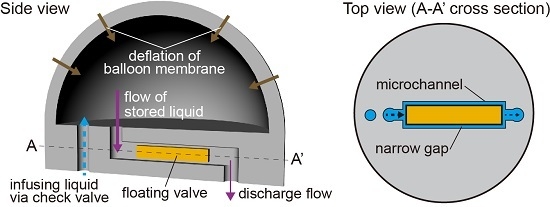Balloon Pump with Floating Valves for Portable Liquid Delivery
Abstract
:1. Introduction
2. Experimental
2.1. Materials
2.2. Device Design and Fabrication
2.3. Setup of the Balloon Pump
2.4. Evaluation of the Balloon Pump
2.5. Microfluidic Operations Using the Balloon Pump
3. Results and Discussion
3.1. Regulation Properties of the Floating Valve
3.2. Discharge Characteristics of the Balloon Pump
3.3. Microfluidic Operations Using the Balloon Pump
4. Conclusions
Supplementary Materials
Acknowledgments
Author Contributions
Conflicts of Interest
References
- Griffiths, A.D.; Tawfik, D.S. Miniaturising the laboratory in emulsion droplets. Trends Biotechnol. 2006, 24, 395–402. [Google Scholar] [CrossRef] [PubMed]
- Dittrich, P.S.; Manz, A. Lab-on-a-chip: Microfluidics in drug discovery. Nat. Rev. Drug Discov. 2006, 5, 210–218. [Google Scholar] [CrossRef] [PubMed]
- Chin, C.D.; Laksanasopin, T.; Cheung, Y.K.; Steinmiller, D.; Linder, V.; Parsa, H.; Wang, J.; Moore, H.; Rouse, R.; Umviligihozo, G.; et al. Microfluidics-based diagnostics of infectious diseases in the developing world. Nat. Med. 2011, 17, 1015–1019. [Google Scholar] [CrossRef] [PubMed]
- Yager, P.; Domingo, G.J.; Gerdes, J. Point-of-care diagnostics for global health. Annu. Rev. Biomed. Eng. 2008, 10, 107–144. [Google Scholar] [CrossRef] [PubMed]
- Tracey, M.C.; Johnston, I.D.; Davis, J.B.; Tan, C.K.L. Dual independent displacement-amplified micropumps with a single actuator. J. Micromech. Microeng. 2006, 16, 1444–1452. [Google Scholar] [CrossRef]
- Cui, Q.; Liu, C.; Zha, X.F. Study on a piezoelectric micropump for the controlled drug delivery system. Microfluid. Nanofluid. 2007, 3, 377–390. [Google Scholar] [CrossRef]
- Pecar, B.; Vrtacnik, D.; Resnik, D.; Mozek, M.; Aljancic, U.; Dolzan, T.; Amon, S.; Krizaj, D. A strip-type microthrottle pump: Modeling, design and fabrication. Sensors 2013, 13, 3092–3108. [Google Scholar] [CrossRef] [PubMed]
- Yang, Y.J.; Liao, H.H. Development and characterization of thermopneumatic peristaltic micropumps. Microelectron. Eng. 2009, 19, 025003. [Google Scholar] [CrossRef]
- Yang, L.J.; Lin, T.Y. A PDMS-based thermo-pneumatic micropump with Parylene inner walls. J. Microelectron. Eng. 2011, 88, 1894–1897. [Google Scholar] [CrossRef]
- Shen, M.; Yamahata, C.; Gijs, M.A.M. A high-performance compact electromagnetic actuator for a PMMA ball-valve micropump. J. Micromech. Microeng. 2008, 18, 025031. [Google Scholar] [CrossRef]
- Su, Y.C.; Lin, L.W.; Pisano, A.P. A water-powered osmotic microactuator. J. Microelectromech. Syst. 2002, 11, 736–742. [Google Scholar]
- Herrlich, S.; Spieth, S.; Messner, S.; Zengerle, R. Osmotic micropumps for drug delivery. Adv. Drug Deliv. Rev. 2012, 64, 1617–1627. [Google Scholar] [CrossRef] [PubMed]
- Martinez, A.W.; Phillips, S.T.; Whitesides, G.M. Three-dimensional microfluidic devices fabricated in layered paper and tape. Proc. Natl. Acad. Sci. USA 2008, 105, 19606–19611. [Google Scholar] [CrossRef] [PubMed]
- Dimov, I.K.; Basabe-Desmonts, L.; Garcia-Cordero, J.L.; Ross, B.M.; Lee, L.P. Stand-alone self-powered integrated microfluidic blood analysis system (SIMBAS). Lab Chip 2011, 11, 845–850. [Google Scholar] [CrossRef] [PubMed]
- Li, G.; Luo, Y.; Chen, Q.; Liao, L.; Zhao, J. A “place n play” modular pump for portable microfluidic applications. Biomicrofluidics 2012, 6, 014118. [Google Scholar] [CrossRef] [PubMed]
- Meyvantsson, I.; Warrick, J.W.; Hayes, S.; Skoien, A.; Beebe, D.J. Automated cell culture in high density tubeless microfluidic device arrays. Lab Chip 2008, 8, 717–724. [Google Scholar] [CrossRef] [PubMed]
- Qiu, X.B.; Thompson, J.A.; Chen, Z.Y.; Liu, C.C.; Chen, D.F.; Ramprasad, S.; Mauk, M.G.; Ongagna, S.; Barber, C.; Abrams, W.R.; et al. Finger-actuated, self-contained immunoassay cassettes. Biomed. Microdevices 2009, 11, 1175–1186. [Google Scholar] [CrossRef] [PubMed]
- Li, W.T.; Chen, T.; Chen, Z.; Fei, P.; Yu, Z.; Pang, Y.; Huang, Y. Squeeze-chip: A finger-controlled microfluidic flow network device and its application to biochemical assays. Lab Chip 2012, 12, 1587–1590. [Google Scholar] [CrossRef] [PubMed]
- Chen, A.; Pan, T. Manually operatable on-chip bistable pneumatic microstructures for microfluidic manipulations. Lab Chip 2014, 14, 3401–3408. [Google Scholar] [CrossRef] [PubMed]
- Iwai, K.; Shih, K.C.; Lin, X.; Brubaker, T.A.; Sochol, R.D.; Lin, L. Finger-powered microfluidic systems using multilayer soft lithography and injection molding processes. Lab Chip 2014, 14, 3790–3799. [Google Scholar] [CrossRef] [PubMed]
- Gong, M.M.; MacDonald, B.D.; Nguyen, T.V.; Sinton, D. Hand-powered microfluidics: A membrane pump with a patient-to-chip syringe interface. Biomicrofluidics 2012, 6, 044102. [Google Scholar] [CrossRef] [PubMed]
- Beebe, D.J.; Moore, J.S.; Bauer, J.M.; Yu, Q.; Liu, R.H.; Devadoss, C.; Jo, B.H. Functional hydrogel structures for autonomous flow control inside microfluidic channels. Nature 2000, 404, 588–590. [Google Scholar] [CrossRef] [PubMed]
- Dendukuri, D.; Panda, P.; Haghgooie, R.; Kim, J.M.; Hatton, T.A.; Doyle, P.S. Modeling of oxygen-inhibited free radical photopolymerization in a PDMS microfluidic device. Macromolecules 2008, 41, 8547–8556. [Google Scholar] [CrossRef]
- Kirby, B.J.; Shepodd, T.J.; Hasselbrink, E.F., Jr. Voltage-addressable on/off microvalves for high-pressure microchip separations. J. Chromatogr. A 2002, 979, 147–154. [Google Scholar] [CrossRef]
- Kim, D.; Beebe, D.J. A bi-polymer micro one-way valve. Sens. Actuator A Phys. 2007, 136, 426–433. [Google Scholar] [CrossRef]
- Tan, W.H.; Takeuchi, S. A trap-and-release integrated microfluidic system for dynamic microarray applications. Proc. Natl. Acad. Sci. USA 2007, 104, 1146–1151. [Google Scholar] [CrossRef] [PubMed]
- Onoe, H.; Okitsu, T.; Itou, A.; Kato-Negishi, M.; Gojo, R.; Kiriya, D.; Sato, K.; Miura, S.; Iwanaga, S.; Kuribayashi-Shigetomi, K.; et al. Metre-long cell-laden microfibres exhibit tissue morphologies and functions. Nat. Mater. 2013, 12, 584–590. [Google Scholar] [CrossRef] [PubMed]
- Morimoto, Y.; Tan, W.H.; Tsuda, Y.; Takeuchi, S. Monodisperse semi-permeable microcapsules for continuous observation of cells. Lab Chip 2009, 9, 2217–2223. [Google Scholar] [CrossRef] [PubMed]
- Morimoto, Y.; Tanaka, R.; Takeuchi, S. Construction of 3D, Layered Skin, Microsized Tissues by Using Cell Beads for Cellular Function Analysis. Adv. Healthc. Mater. 2013, 2, 261–265. [Google Scholar] [CrossRef] [PubMed]
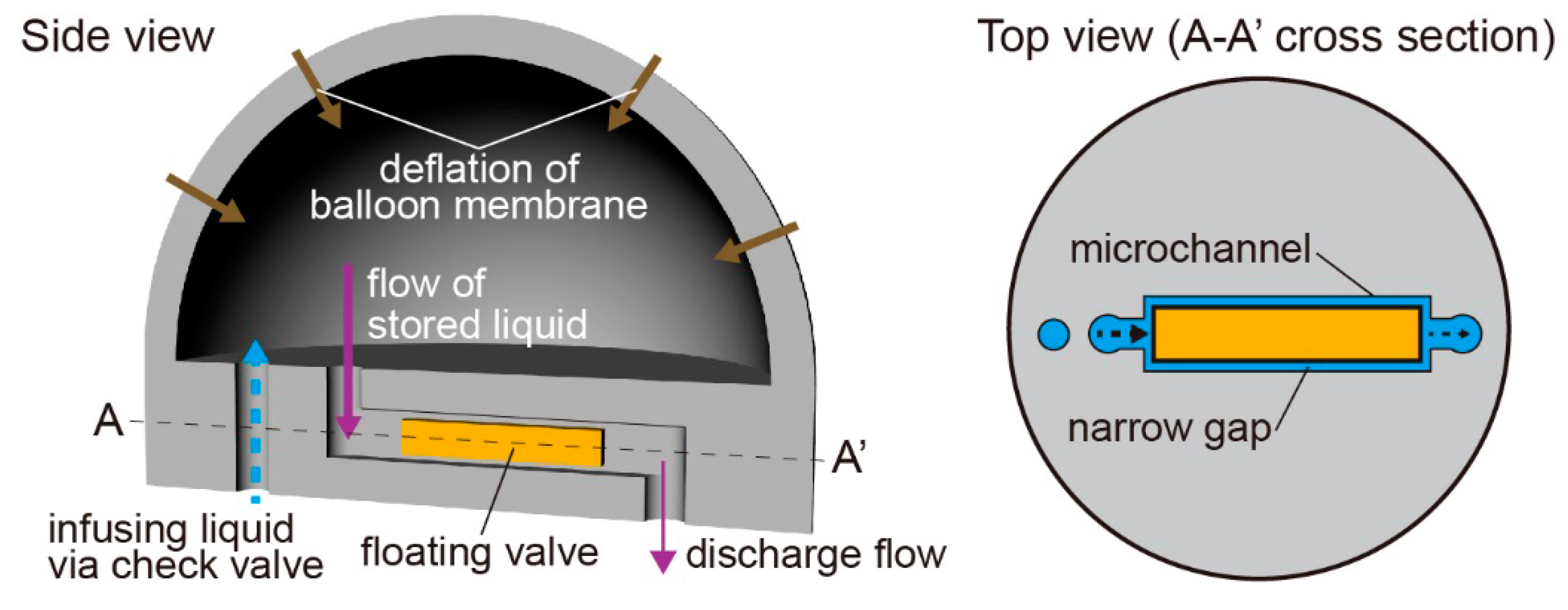
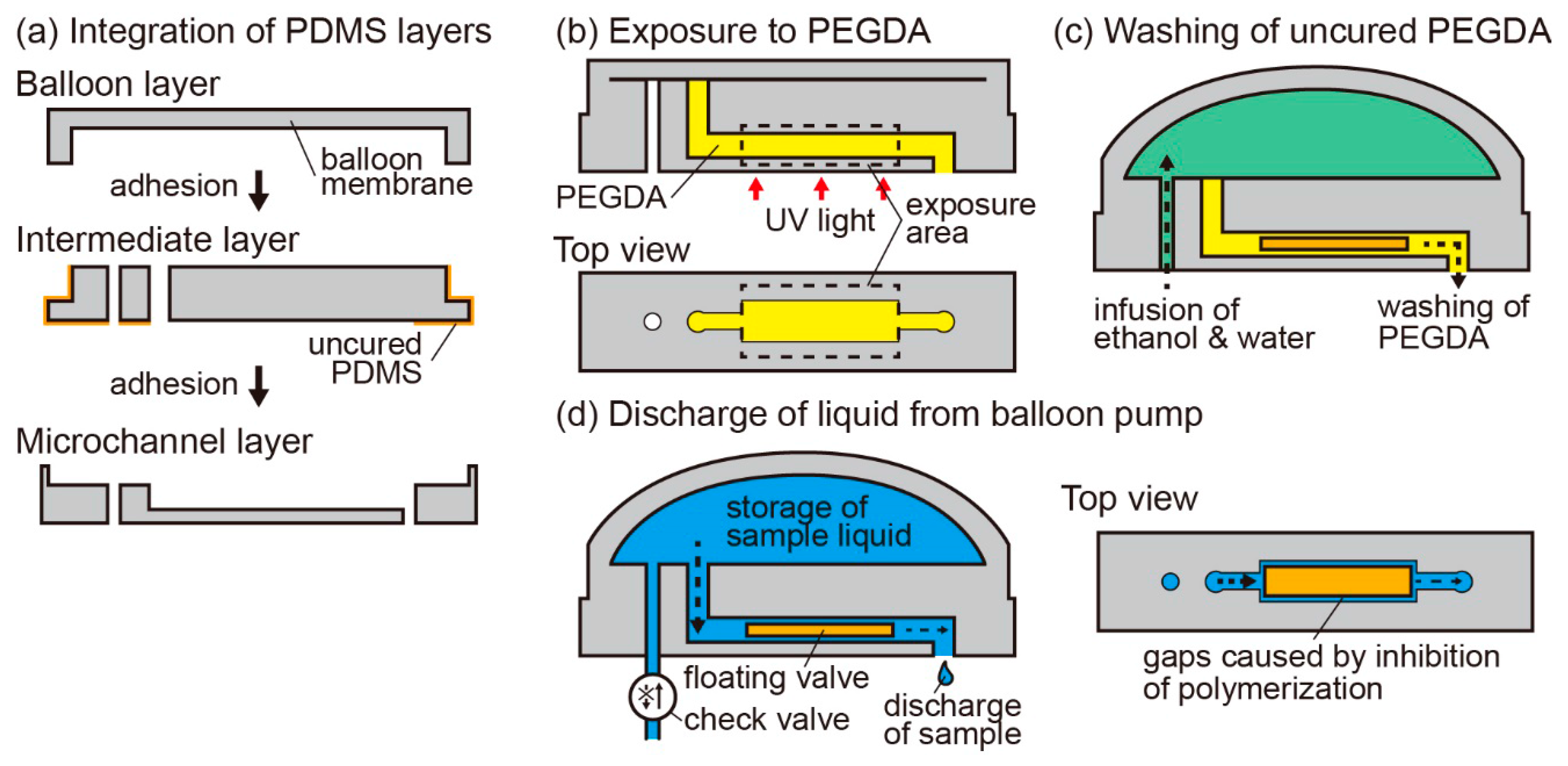
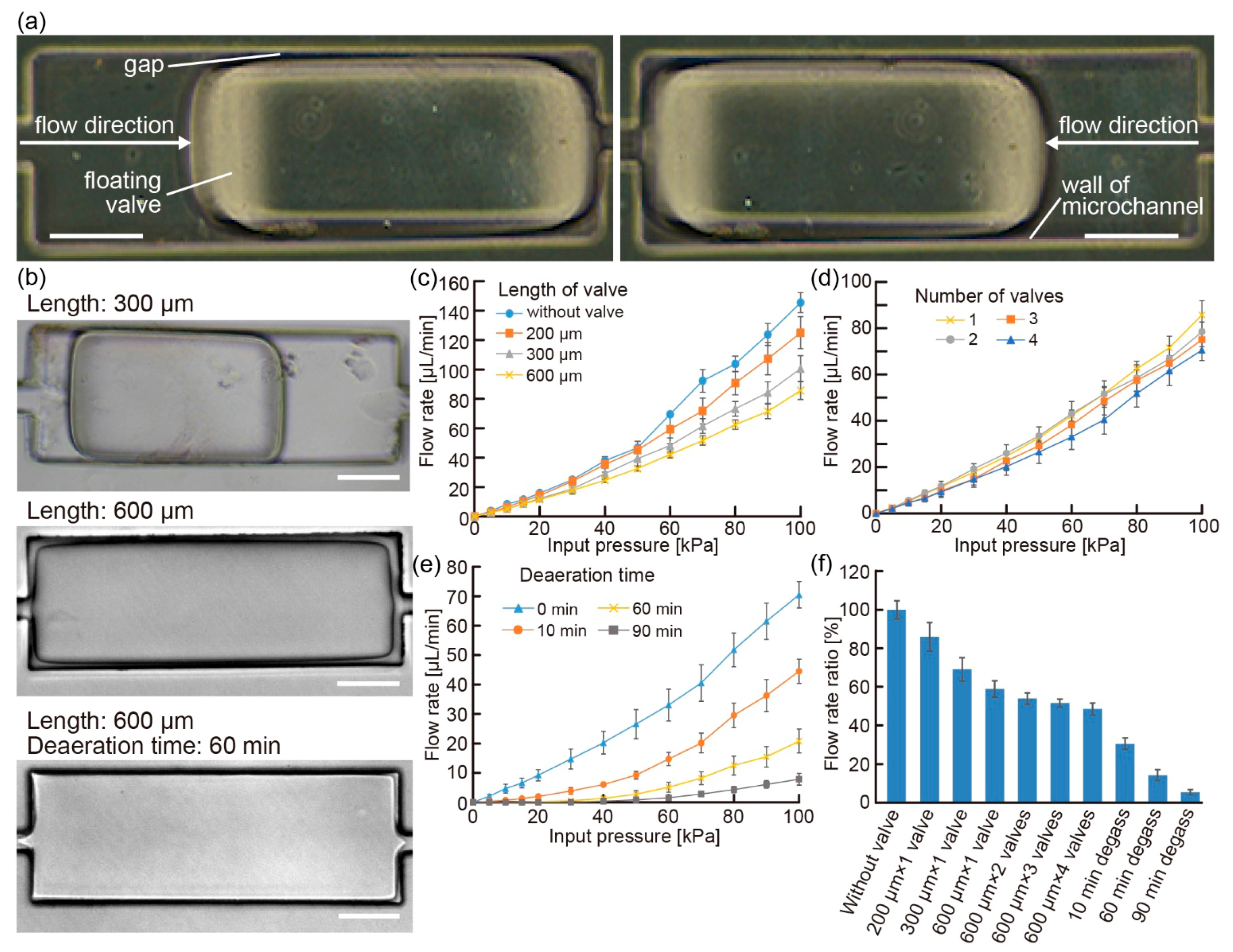
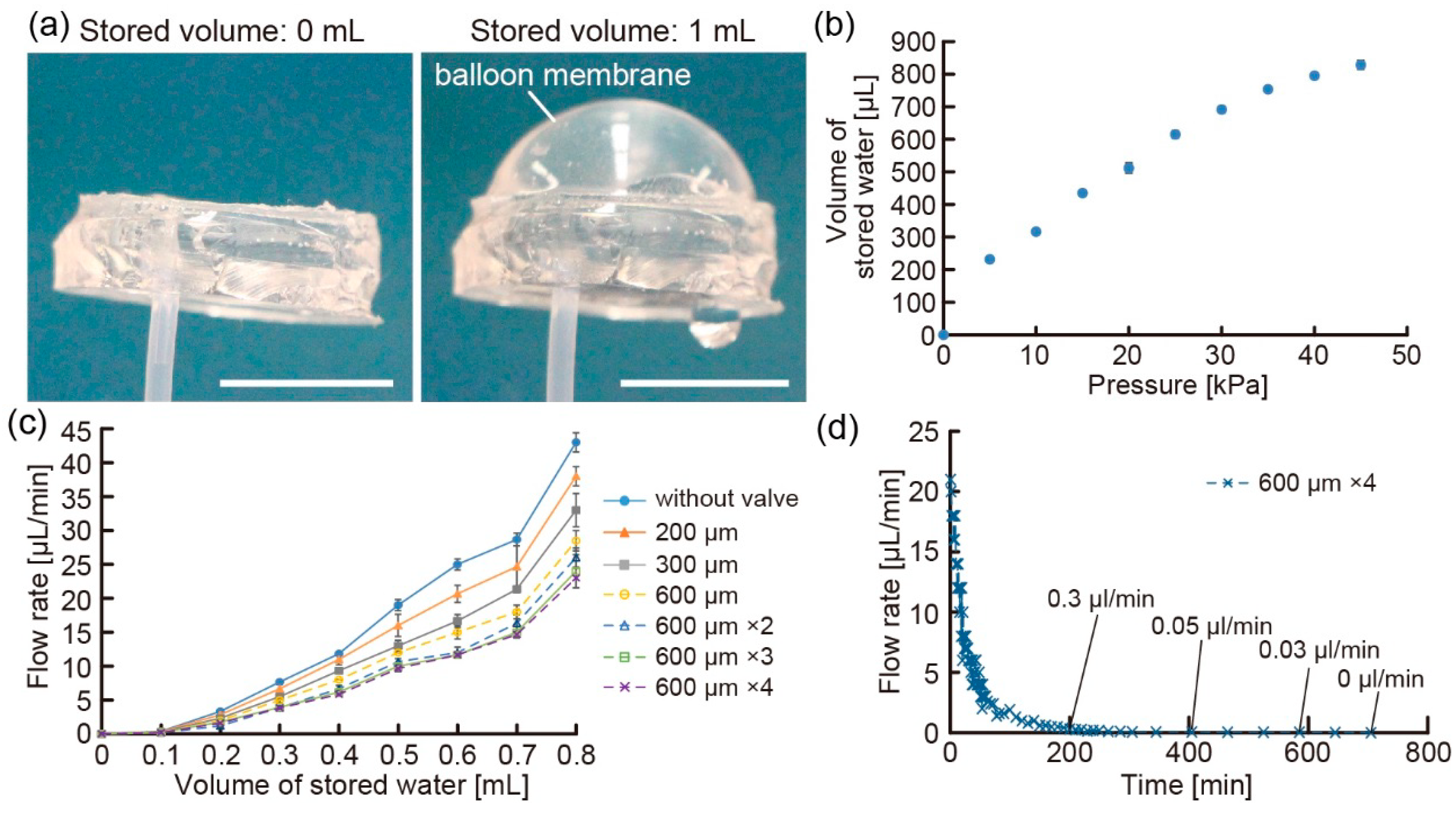
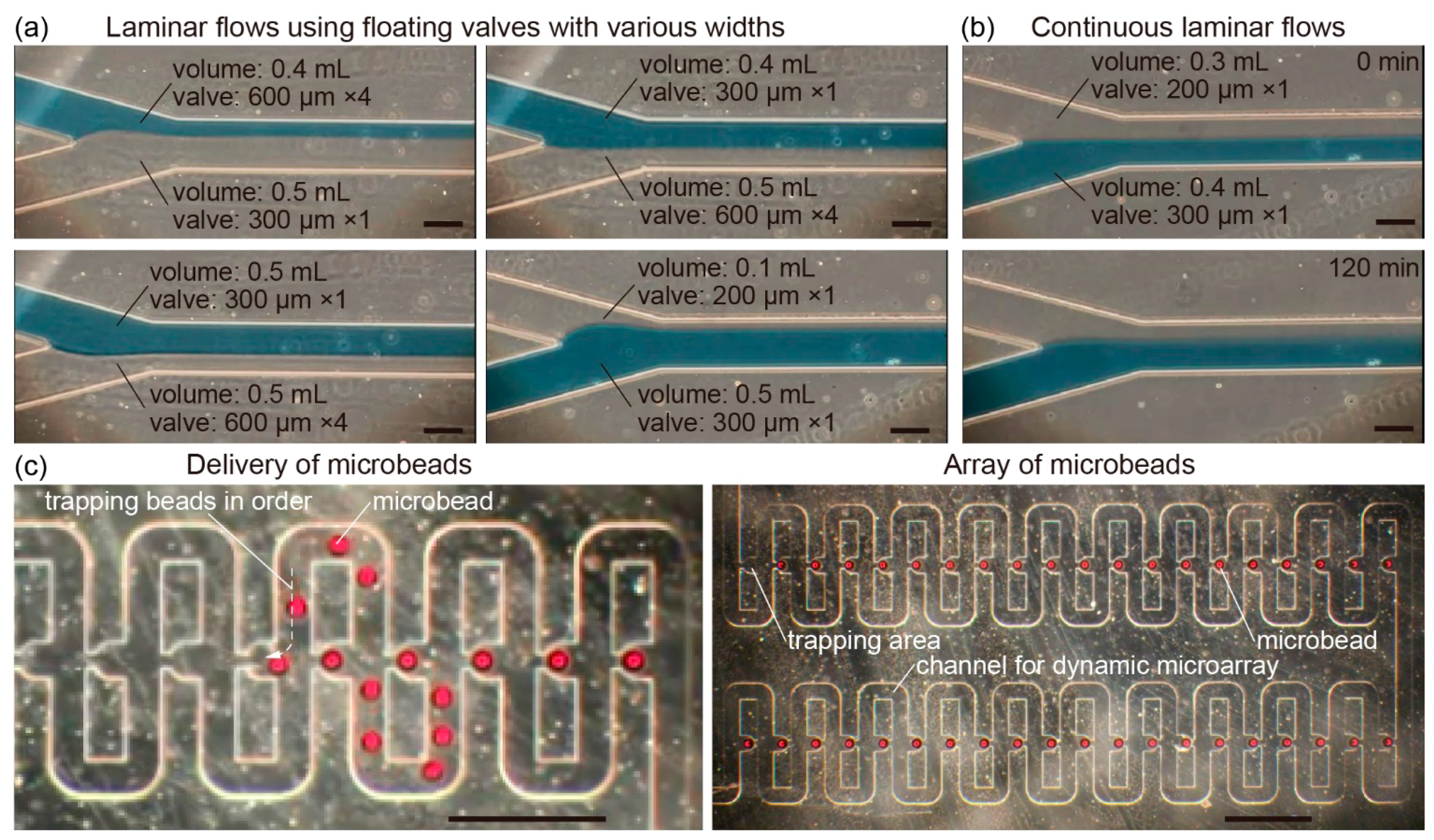
© 2016 by the authors. Licensee MDPI, Basel, Switzerland. This article is an open access article distributed under the terms and conditions of the Creative Commons by Attribution (CC-BY) license ( http://creativecommons.org/licenses/by/4.0/).
Share and Cite
Morimoto, Y.; Mukouyama, Y.; Habasaki, S.; Takeuchi, S. Balloon Pump with Floating Valves for Portable Liquid Delivery. Micromachines 2016, 7, 39. https://doi.org/10.3390/mi7030039
Morimoto Y, Mukouyama Y, Habasaki S, Takeuchi S. Balloon Pump with Floating Valves for Portable Liquid Delivery. Micromachines. 2016; 7(3):39. https://doi.org/10.3390/mi7030039
Chicago/Turabian StyleMorimoto, Yuya, Yumi Mukouyama, Shohei Habasaki, and Shoji Takeuchi. 2016. "Balloon Pump with Floating Valves for Portable Liquid Delivery" Micromachines 7, no. 3: 39. https://doi.org/10.3390/mi7030039
APA StyleMorimoto, Y., Mukouyama, Y., Habasaki, S., & Takeuchi, S. (2016). Balloon Pump with Floating Valves for Portable Liquid Delivery. Micromachines, 7(3), 39. https://doi.org/10.3390/mi7030039




